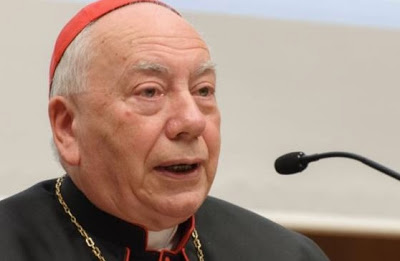

| Online: | |
| Visits: | |
| Stories: |

| Story Views | |
| Now: | |
| Last Hour: | |
| Last 24 Hours: | |
| Total: | |
TradCatKnight: Cardinal Coccopalmerio: Need to Revisit Notion of Sacraments as only either Valid or Invalid
Cardinal Coccopalmerio: Need to Revisit Notion of Sacraments as only either Valid or Invalid
Consider the latest from Cardinal Francesco Coccopalmerio, the president of the Vatican’s Pontifical Council for Legislative Texts. In an interview conducted by Ed Pentin of the National Catholic Register, published Mar. 1, the curial “cardinal” said:
We say, everything is valid; nothing is valid. Maybe we have to reflect on this concept of validity or invalidity. The Second Vatican Council said there is a true communion [between Catholics and Protestants] even if it is not yet definitive or full. You see, they made a concept not so decisive, either all or nothing. There’s a communion that is already good, but some elements are missing. But, if you say some things are missing and that therefore there is nothing, you err. There are pieces missing, but there is already a communion, but it is not full communion. The same thing can be said, or something similar, of the validity or invalidity of ordination. I said let’s think about it. It’s a hypothesis. Maybe there is something, or maybe there’s nothing — a study, a reflection.
(“Cardinal Coccopalmerio Explains His Positions on Catholics in Irregular Unions”, National Catholic Register, Mar. 1, 2017)
Ah yes, “reflecting” on traditional Catholic doctrine is how it all starts: Modernists love to “re-think” prior teaching, which is always the first step to dismantling it, usually under the pretext of penetrating deeply into the “real” meaning of the teaching. Curiously, the “real” meaning usually ends up being a denial of the previous meaning, which is how you know that theirs is not a genuine development of the doctrine but a corruption of it. In any case, let’s examine Mr. Coccopalmerio’s argument.
In 1964, the Second Vatican Council invented the idea that the Church of Jesus Christ exists in elements in other religions while fully subsisting in the Catholic Church:
This Church [founded by Jesus Christ] constituted and organized in the world as a society, subsists in the Catholic Church, which is governed by the successor of Peter and by the Bishops in communion with him, although many elements of sanctification and of truth are found outside of its visible structure. These elements, as gifts belonging to the Church of Christ, are forces impelling toward catholic unity.
(Vatican II, Dogmatic Constitution Lumen Gentium, n. 8)
Although this primary source text alone may perhaps leave some wiggle room for precisely how this teaching is to be understood, the post-conciliar magisterium has resolved all doubt in favor of a heretical understanding, for the Novus Ordo Church since Vatican II has affirmed time and again that “elements” of the Catholic Church exist in other (i.e. heretical and schismatic) “churches” and ecclesial communities, and it has acted accordingly towards them:
The elements of this already-given Church exist, found in their fullness in the Catholic Church and, without this fullness, in the other Communities, where certain features of the Christian mystery have at times been more effectively emphasized. Ecumenism is directed precisely to making the partial communion existing between Christians grow towards full communion in truth and charity.
(Antipope John Paul II, Encyclical Ut Unum Sint, n. 14)
With this last sentence, John Paul II shows why this doctrine of ecclesial elements — sometimes called Frankenchurch or patchwork ecclesiology — was of fundamental importance at Vatican II: in order to enable and give a doctrinal foundation to ecumenism. Without this doctrinal change from Pope Pius XII’s clear and exclusive identification of the Church of Jesus Christ with the Catholic Church (see Encyclical Mystici Corporis, n. 13) to Vatican II’s “subsists in” heresy, the ecumenical program would have been impossible.



